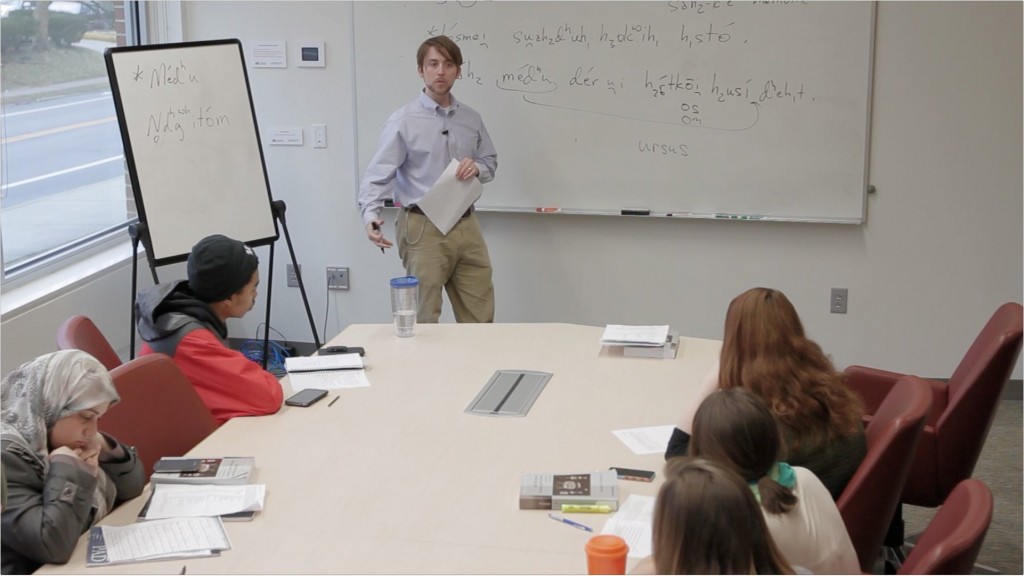For those teachers of Indo-European linguistics out there, I thought it might be helpful to detail how my students were able to compose an Indo-European fable on their own.
I first began with an English-only homework, in which they were to compose their very own fable in PIE. These were the instructions:
Consulting the Proto-Indo-European word index found on pages 510-515 of Fortson’s Indo-European Language & Culture (see the referred page numbers for word meanings), write a PIE fable in the style (and length) of the “Sheep and the Horses”. For this assignment you need only to write the fable in ENGLISH, using ONLY those words listed within Fortson’s word index. (We will translate it into PIE at a later date.)
Your fable should include the following words:
- “bear”
- “woman”
- “honey”
- “smoke”
- “put”
- “snake”
- “house”
- “sweet”
- “eye”
- “see”
- “nose”
- “sense”
- “mouth”
- “tongue”
- “taste”
All other words that you use will be at your discretion. Remember: you may use ONLY those words listed in Fortson’s word index.
Using an online polling service, we then voted on the best fable, and Erica Mattingly won by a fairly healthy margin. Her original fable went as follows:
“There was a woman, wife of the king. She had everlasting fame for her sweet honey. A bear smelled the honey and went to her house to taste it. The woman saw the bear and thought he had sweet eyes. She put honey on a tree for the bear at dawn. The drunken king came to the house, saw the bear with honey on its nose, tongue, and mouth, and was furious. He made a fire with a lot of smoke, and the bear went away. The drunken king did not see, but a big snake came and took the queen. The bear returned to kill the snake and carry the queen to her house. The queen gave her heart to the bear, and the bear became a man.”
Though we could only choose just one, there were a number of other excellent fables composed. Here’s one of my favorites (though imagine how hard this would be to translate), written by Leah Hatch:
There was a Bear who lived in a cave in the woods. One day he smelled a sweet aroma. He raised his big head and sniffed the air. Bear thought, “the woman who lives in the house on the edge of forest must be making honey-cakes”. He followed his nose and walked out of his cave. On his way to see what the sweet scent was he ran into a Snake. Bear saw the way that Snake’s tongue flicked out of his mouth and asked him “Snake, why is it that your tongue flicks out of your mouth like that?” Snake said, “I do not smell the same way you do, Bear. I smell with my tongue, not my nose.” Bear looked at Snake and said,“you are an odd animal, do you see with your nose and taste with your eyes?” Snake said, “no, you silly animal. I am normal compared to you, who sleeps all through the winter.” Bear stared at Snake before speaking again. “What were you smelling when I came across you? Was it the honey-cakes that the woman at the edge of the forest makes?” Snake replied, “I did smell those at first but now all that I can smell is the faint smell of smoke.”Bear nodded before walking ahead. Snake turned his head to watch him go. “Where are you going Bear?” “I am going to help put the fire out. The woman may bake delicious honey-cakes, but she is also clumsy and sets fire to her cakes a lot. I am going to help put the fire out”.
Returning now to Erica’s fable, there were a couple syntactic constructions that immediately jumped out at me as being too hard to translate, such as the infinitival purpose clause “went to her house to taste it”. But by and large Erica’s fable remained intact for the final assignment, though I did take the liberty of omitting articles and existential “there”s to ease translation.
Here is the modified version:
(There) was (a) woman. She was (the) wife of (the) king. To her (there) was everlasting fame for (her) sweet honey. A bear smelled (the) honey and went to her house and tasted it. The woman saw (the) bear and thought: “To him are sweet eyes.” She put honey onto (a) tree for (the) bear at dawn. The drunken king went to the house, saw honey on the bear’s nose, tongue, and mouth, and was furious. He made (a) fire with much smoke, and (the) bear went away. The drunken king did not see, but (a) big snake came and took (the) queen. (The) bear returned and killed (the) snake. He carried (the) queen to her house. The queen gave her heart to (the) bear, and (the) bear became (a) man.
At this point the students were asked to translate the fable into PIE, with the vocabulary arranged as follows: nouns were given in the nominative singular & genitive singular, verbs in the third singular active indicative. Students were instructed not to translate those words given in parentheses.
- “to be” *h1esti
- “woman” *gwénh2, *gwnéh2s (animate noun)
- “he, she, it” (nom.sg.) *só, *séh2, *tód
- “he, she, it” (dat.sg.) *tósmei̯, *tósi̯eh2ei̯, *tósmei̯
- “he, she, it” (gen.sg.) *tósi̯o, *tósi̯eh2s, *tósi̯o
- “wife” *pótnih2, *potnii̯éh2s (animate noun)
- “king” *h3rḗḱs, *h3réḱs (animate noun)
- “for” (use dative)
- “sweet” *su̯éh2du- (u-stem adjective)
- “honey” *médhu, *mədhéu̯s (neuter noun)
- “everlasting” *n̥dhgwhitó- (o-stem adjective)
- “fame” *ḱléu̯os, *ḱléu̯eses (neuter s-stem)
- “bear” *h2ŕ̥tḱos, *h2ŕ̥tḱosi̯o (animate noun)
- “to smell” *h3edi̯eti
- “to go” *h1ei̯ti
- “house” *dóms, *déms (animate noun)
- “to taste” *ĝeĝou̯se
- “to see” *derḱt
- “to think” *memone
- “eye” *h3ókws, *h3ékws (animate noun)
- “to put, make” *dheh1t
- “tree” *dóru, *dérus (neuter noun)
- “dawn” *h2éu̯sōs, *h2usés (animate noun)
- “drunken” *madtó- (o-stem adjective)
- “nose” *nā́s, *nasés (animate noun)
- “tongue” *dn̥ĝhu̯éh2, *dn̥ĝhu̯éh2s (animate noun)
- “mouth” *h1óh1s, *h1eh1sés (neuter noun)
- “to be angry” *mn̥i̯etor
- “fire” *páh2u̯r̥, *pəh2u̯éns (neuter noun)
- “much” *pélh1us, *pl̥h1u̯és (u-stem adjective)
- “smoke” *dhuh2mós (animate noun)
- “to go away” *ápo … h1ei̯ti
- “not” *né
- “big” *méĝh2onts, *məĝh2n̥tés (nt-stem adjective)
- “snake” *h1ógwhis, *h1égwhis (animate noun)
- “queen” *h3rḗĝnih2, *h3rḗĝnii̯éh2s (animate noun)
- “took” *selh1t
- “to return” *ápo … gwemt
- “to kill” *gwhent
- “give” *deh3t
- “heart” *ḱḗr, *ḱr̥dés (neuter noun)
- “become” *bhuh2t
- “man” *h2nḗr, *h2n̥rés (animate noun)
The students then came to class and we translated it as a group, with each student giving their translation in the “Round Robin” format.

Putting the fable together
Overall, I feel that this exercise was both fun and instructive for the students. Such an activity would prove especially helpful for those teaching Indo-European linguistics to students who have not studied any ancient IE languages at all, as it gives them hands-on experience over the function of different grammatical inflections, head-final word order, etc. But even cooler for the students was that theirs was the third fable ever composed in PIE in modern times. And in my opinion, it’s the most entertaining one as well!
AMB
